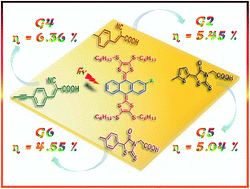Effect of spacers and anchoring groups of extended π-conjugated tetrathiafulvalene based sensitizers on the performance of dye sensitized solar cells†
Abstract
Four new extended π-conjugated tetrathiafulvalene (ex-TTF) based dyes featuring a donor–π–acceptor (D–π–A) configuration with varying π-spacers and anchoring groups were synthesized and characterized. The sensitizer having the 4-ethynyl phenyl π-spacer (G4) shows red shifted absorption maxima in comparison with the sensitizer having only the phenyl π-spacer (G2). All four sensitizers undergo reversible oxidations to form stable radical cations. TDDFT calculations highlighted that the LUMO of the G4 sensitizer is more stabilized by the incorporation of the ethynyl group between the π-spacer and the cyanoacrylic acid anchoring group that aid to inject electrons efficiently into TiO2 thereby resulting in an enhanced power conversion efficiency of 6.36% when compared to the other derivatives, which is also confirmed by the intensity-modulated photovoltage spectroscopy (IMVS) method. Kinetic studies demonstrated that fast regeneration of the oxidized dye by the redox couple is an important factor behind enhanced efficiencies in solar cells. Finally, the performance of the present sensitizers is compared to that of previously reported sensitizers.


 Please wait while we load your content...
Please wait while we load your content...